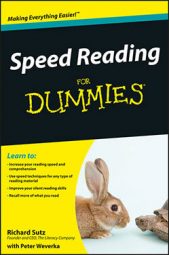Skimming — getting the essence from reading material without reading all the words — boils down to knowing what parts to read and what parts to pass by. Following are some tips and techniques for recognizing what is important to read in the act of skimming.
Know what you want
Before you start skimming, ask yourself what you want to get from the book or article under your nose. Think of two or three terms that describe what you want to know, and as you skim, keep an eye out for those two or three terms. Aimlessly skimming with no particular purpose can cause drowsiness, and eventually, sleep.
Read vertically as well as horizontally
When skimming, you move your eyes vertically as much as you move your eyes horizontally. In other words, you move your eyes down the page as much as you move them from side to side. Skimming is a bit like running down stairs. Yes, you should take one step at a time, and running down stairs is reckless, but you also get there faster by running.
Think like the author
Every article, book, and Web page is written to make a point of some kind, and if you can detect the author’s strategies for making his point, you can separate the important from the unimportant material in the course of your reading. You can focus on the original, meaningful material and skip over the material that just supports the author’s argument without advancing it.
Detecting the author’s strategies requires you to put yourself in his place. Besides noticing the material on the page, notice how he presents the material. See whether you can recognize how the author places background material, secondary arguments, tangential information, and just plain frippery.
Preread before you start skimming
Examine an article before you read it. By prereading an article before you skim, you can pinpoint the parts of the article that require your undivided attention and the parts that you can skip.
Try to detect the main idea in the introductory paragraphs
The introductory paragraphs usually express the main idea, argument, or goal of an article or chapter. Read these paragraphs closely. They tell you what the author’s aim is, which can help you decide early on whether the article or chapter is worth reading in detail.
Read the first sentence in each paragraph
The introductory sentence of each paragraph usually describes what follows in the paragraph. When you skim, read the first sentence in each paragraph and then decide whether the rest of the paragraph deserves a read. If it doesn’t, move on.
Don’t necessarily read complete sentences
When skimming, you don’t even have to read complete sentences. If the start of a sentence holds no promise of the sentence giving you the information you want, skip to the next sentence. Read the start of sentences with an eye to whether they will yield useful information, and read them all the way through only if they appear to be useful at first glance.
Skip examples and proofs
Authors often present examples to prove a point, but if you believe the point doesn’t need proving, you can skip the examples.

